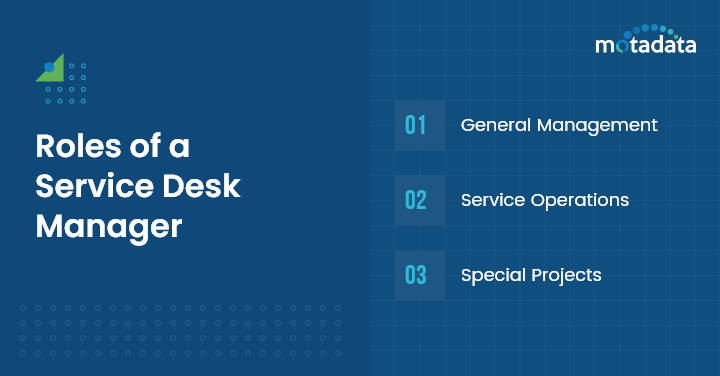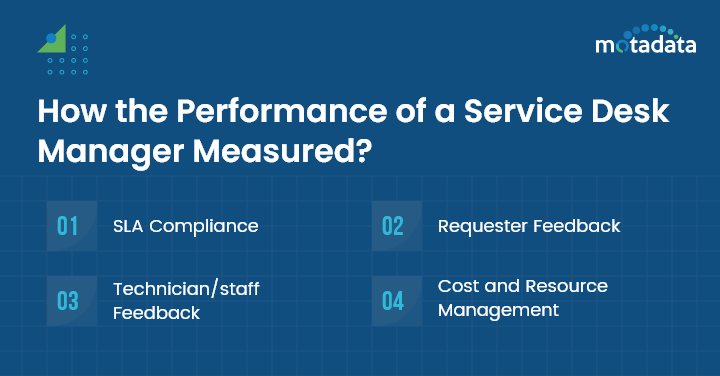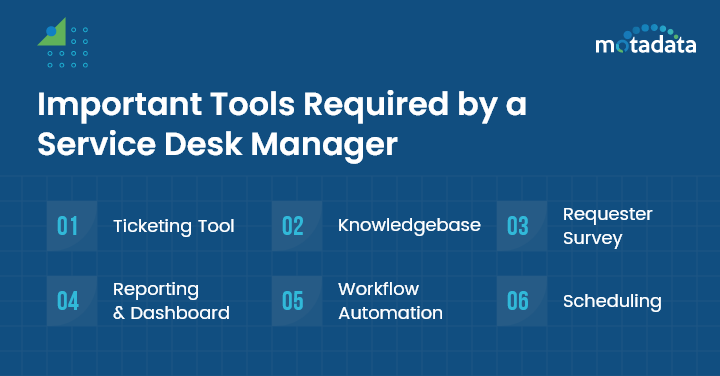Are you aspiring to be a IT service desk manager? If yes, then you are looking ahead to a challenging yet exciting career ahead. As I write this blog, I did a quick LinkedIn search and found 9,181 job opening for Service Desk Manager in the US alone.
The average salary of a service desk manager is $74,169 in the US according to PayScale. The job of a service desk manager is critical to the functioning of ITSM in an organization. He/she is responsible for managing the day to day operations of the service desk. A grand orchestration to make sure business is receiving the right IT service at the right time.
Roles of a Service Desk Manager

Let’s discusses what a service desk manager does. The answer isn’t straight forward as it sounds.
A service desk manager has three broad roles to play:
- General Management
- Service Operations
- Special Projects
General Management
In most IT organizations, the service desk often represents the largest single function comprising of large teams with multiple shifts and locations.
Managing the service desk requires general people management skills, which involves the following activities:
- Hiring new technicians.
- Training technicians.
- Managing the shift of the technicians.
- Managing any third-party vendors.
- Defining best processes.
- Cost management and budgeting for the department.
A service desk manager has to wear many hats. He/she is involved in the operations to make sure tickets are resolved in a timely manner; he/she may also be involved in other business-impacting initiatives.
Service Operations
Apart from the general management role, a IT service desk manager is responsible for a critical function which is timely service delivery. A service desk processes a large number of requests, and all of them have to be resolved within a defined SLA. The onus is on the service desk manager to make sure the SLA requirements are met, for which the manager performs some common service operations activities:
- Training and Mentoring.
- Make sure tickets are assigned based on workload.
- SLA monitoring and compliance check.
- Communication and collaboration.
- Monitor operational performance.
- Reporting.
- Continuous improvement.
- Manage shift handoffs.
In most organizations, service desk operations are based on a standard framework for example ITIL. In most cases, service desk managers are implementing a framework, and they have a certification and experience to back their work.
Special Projects
Since the service desk is a valuable function in an organization, the service desk manager attains important experience which he/she sometimes uses in other business activities. He/she will either participate directly or oversee a small team involved with the activities. The goal of involving the service desk manager in special projects is to minimize potential disruptions to the business due to any kind of changes.
IT Service Desk Managers: Large vs. Small Organizations
Small Organizations
Service desks in small organizations operate with lean teams where resources often wear multiple hats. This makes the role of a service desk manager deeply hands-on.
Here, the service desk manager is often involved in day-to-day operations.
If we talk about the responsibilities of a SDM in a small organization, it includes:
- Managing all the user requests and ticket resolution
- Resolving technical issues by utilizing their broad spectrum of technical skills
- Driving skill development and knowledge enhancement by providing mentorship, guidance, and training to the service desk staff
Large Organizations
Service desks in larger organizations are more structured, acting as a specialized unit. The role of a SDM in this case is more about coordination and oversight.
Some of the key responsibilities of an SDM in a larger organization involves:
- Ensuring a conducive work environment by overseeing performance and development of the specialized team.
- Ensure efficient ticket resolution by managing ticket escalations and coordinating workflows with the specialized teams.
- Engage with vendors, negotiate contracts, and ensure SLA adherence for service delivery standards.
- Enhance efficiency and user satisfaction by optimizing processes, adopting best practices, and driving continuous improvement initiatives.
What’s the Value of an IT Service Desk Manager
IT service desk manager is an invaluable part of an IT organization, because:
- They oversee all the operations of their service desk staff
- They act as a single point of contact for all ITSM functions, making them influential and knowledgeable participants.
- They act as an escalation contact for every other crucial issue
- They continuously engage with subject-matter experts to eliminate or restrict impacts on the overall business operations
What are the Skills Required to Become a Service Desk Manager (SDM)?
There’s no doubt that the service desk manager is one of the most challenging roles in IT organizations. The job requires a complex combination of skill, mind-set, and experience.
Here are a few points to get you started:
1. General Management Skills:
SDM is basically a juggling act between various activities.
2. Work in a group with empathy:
A service desk is a high-tension place, which has an impact on the inter-personal relationships among the technicians and with the clients. A good SDM should have the emotional maturity to handle the mayhem and manage the people.
3. Have the ability to resolve conflict:
Not all tickets get resolved on time some get escalated, and when they get escalated clients (requesters) sometimes get angry. It’s the job of the SDM to tackle such tricky requester tactfully.
4. Help people prioritize their work:
In an ideal situation, business rules and automation are used to distribute tickets across technicians. Sometimes, certain tickets may require special attention and more resources. In such situations, SDM may overwrite rules and allot more resources to a single ticket for speedier resolution.
5. Understanding the impact of a situation:
SDM has to perform an impact assessment of critical incidents coming to the service desk. Here the experience of the SDM plays a crucial role. Be a line of communication with the management and other business stakeholders: SDM is the face of the service desk for the management. If the management wants to know anything about service desk, they have to get it from the service desk manager. Generally, reporting is a mandate for an SDM to communicate KPIs to higher management.
6. Extract data for decision making:
An astute SDM should have the skills to consume operational data and make meaningful insight out of it. Motadata ITSM offers out of the box reporting capability to measure SLA performance and many more. Try Motadata 30 Days Free of Cost.
How the Performance of a Service Desk Manager Measured?
Generally, organizations measure the performance of a service desk manager both at an operational level, assessing how their team is performing, and at a personal level, evaluating how effective they are working with people.
The evaluation employs both objective and subjective parameters with the aim of generating a holistic perspective.
Some of the critical success factors include, but not limited to, are:
- SLA Compliance
- Requester Feedback
- Technician/staff Feedback
- Cost and Resource Management
It’s important for the service desk manager to have the necessary autonomy to make operational changes so he/she can achieve performance targets.
Important Tools Required by a Service Desk Manager(SDM)
Technology is a great enabler for a service desk manager.
Powerful software like Motadata ITSM provides service desk managers tools that give them data and operational capabilities. Such tools drastically increase the scale of operation and service visibility.
Here are some common tools used by most service desk managers:
- Ticketing Tool: Also called as incident management or help desk system. It is the primary tool for managing a service desk, which helps technicians to process all incoming tickets.
- Knowledgebase: Allows service desk manager to create a repository of useful information which could be a collection of common solutions.
- Requester Survey: Allows the SDM to capture the sentiment of the requesters (clients) towards the service desk.
- Reporting and Dashboard: Allows the service desk manager to track and report KPIs of the service desk.
- Workflow Automation: Allows the SDM to automate repetitive tasks and enforce business rules.
- Scheduling: Allows SDM to schedule for staff resource to cover organizational support needs.
Conclusion
A service desk is an integral part of any IT organization. Without a service desk there will be no IT services, and to enable an effective service desk an organization has to employ a capable service desk manager. The job of an SDM has multiple facets and understanding it will allow an IT organization to see the bigger picture of sound IT operations.
FAQs:
The IT Service Desk Manager oversees the IT service desk operations, ensuring effective incident management, problem resolution, and service delivery to support organizational needs.
They implement best practices, streamline processes, analyze performance metrics, and foster collaboration among team members to enhance service efficiency and user satisfaction.
Common challenges include managing user expectations, dealing with high volumes of incidents, ensuring team productivity, and adapting to rapidly changing technologies.
Important metrics include response and resolution times, ticket volumes, user satisfaction scores, and first contact resolution rates to assess the service desk’s performance.





